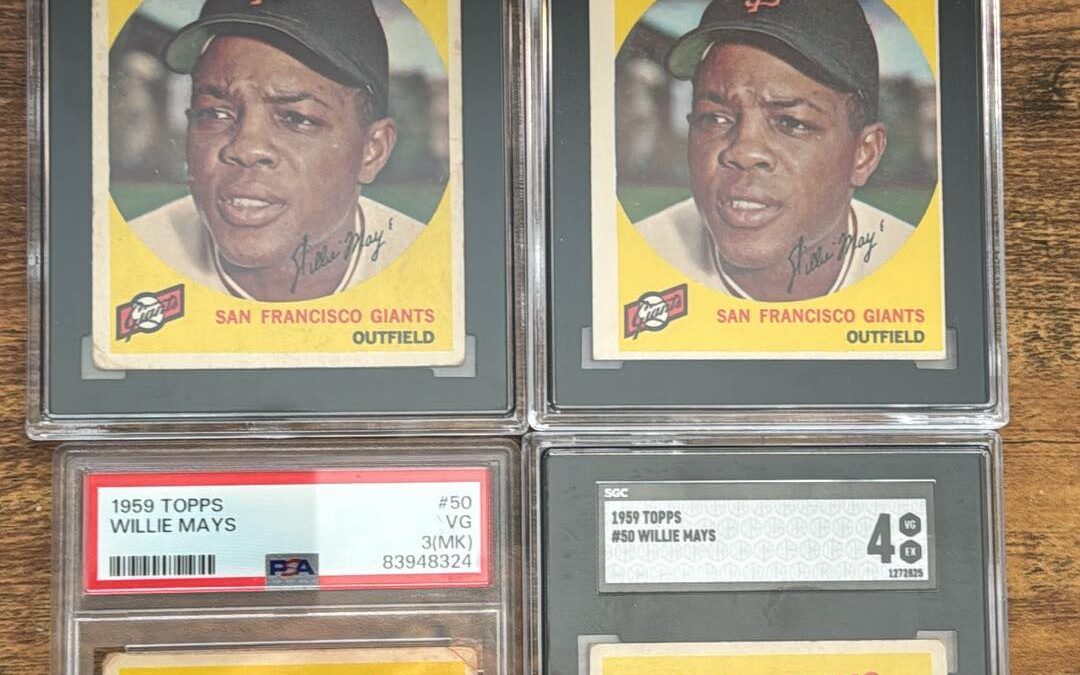PSA Statement on Eye Appeal and Subjectivity in Card Grading
While perusing PSA’s web site the other day I saw a blurb I had not noticed before. On the page that explains their grading standards, towards the bottom, there is a button titled “The Importance of Eye Appeal and Subjectivity in Grading.”
It reads, in part:
“…the vast majority of grading is applied with a basic, objective standard but no one can ignore the small (yet sometimes significant) subjective element. This issue will usually arise when centering and/or eye appeal are in question. For example, while most cards fall clearly within the centering guidelines for a particular grade, some cards fall either just within or just outside the printed centering standards. The key point to remember is that the graders reserve the right, based on the strength or weakness of the eye appeal, to make a judgment call on the grade of a particular card.” (the bold is in the original as well)
They continue by explaining unique scenarios where cards that might not “technically” be eligible for a given grade, let’s say 5 / EX, would be awarded 5 due to grader discretion regarding overall eye appeal. Or the inverse: a card that objectively meets 5 / EX might be graded “down” due to poor eye appeal as determined by the grader.
I have written a lot here recently about the state of the market in general, and factors that affect condition and value, and the topic of “eye appeal” has come up in many resulting conversations.
The most frequent mention is the role of centering in determining eye appeal and thus value. So, what is eye appeal, and how does subjectivity play into the grading process? And ultimately, is the human element a necessary part of card grading?
What Is “Eye Appeal”?
PSA and SGC both explicitly mention “eye appeal” in their grading standards. For example a PSA 5 may have several light surfaces scratches but that “do not detract from the appeal” of the card. SGC mostly mentions “eye appeal” in describing half grades: a 4.5 is basically “a VG/EX card that exhibits high-end overall quality and eye appeal.” So it’s like a 4, but just . . . looks a bit better. It’s one of those things: “I know it when I see it,” and is hard to quantify (hence subjective).
- Same Grades, Different Appeal
Is Eye Appeal Inherently Subjective?
There are many aspects of eye appeal. Perhaps the biggest factor is centering. Any collector knows: cards that are centered for the grade tend to outsell off center cards. Is this a subjective concept? Maybe not entirely.
One article on the subject of symmetry states it this way: According to the American scientist Alan Lightman, human brains actually strive to see things symmetrically. “The reason must be partly psychological,” he says. “Symmetry represents order, and we crave order in this strange universe we find ourselves in… [It] helps us make sense of the world around us.” On some level, the human drive for symmetry might be closer to objective than we think.
Personally, I think the move to online marketplaces has put even more emphasis on centering than, say, 30 years ago. When looking at pictures online, centering is the first thing you see–and the only aspect you can evaluate with certainty. In person, an original surface really shines, and maybe your tolerance for centering loosens a bit.
Of course, there are other factors to consider. A crease in an otherwise boring background area of a card image might not be that distracting, but the same size crease through Babe’s eyeballs is very off-putting.
If eye appeal is mostly subjective, the idea of “grader discretion” leads to further questions: who is the grader? What is their knowledge or experience? Grading is a field with no set qualifications or standards, and starting salary is very low. So whose discretion are we talking about? That matters.
Technical Grade vs. Eye Appeal
A lot of collectors conflate technical grade with eye appeal. Especially at lower grades, the differences between eye appeal for two 1.5s, for example, can be stark. And a card can “look like a 7” but grade, correctly, as a 5 due the the presence of a wrinkle that you can only see when the light hits just right. The market values these differences, quite literally.
For example, I shopped long and hard for a ’54 Hank in a presentable 1.5 grade. Most look more like the second example.
Ask any dealer: cards with strong eye appeal for the grade simply hold more value. Dealers ask more for them, and buyers tend to pay up for the best card they can find at the desired grade. Even for your personal collection, it’s worth taking time to really shop around–who wouldn’t rather look at a prettier card?
Chris Tanton of Southern Gems Memorabilia states that “as a seller, I tend to price strong eye appeal items up towards the high end of recent sales. I know that someone will eventually be willing to offer an above average number for cards like that. When I post strong eye appeal vintage cards in Facebook groups, I almost always get offers in line with average comps almost immediately.”
He continues, “Cards that aren’t as strong for the grade tend to sit a while, or they need to be moved below average comps by 10 to 20%.” This trend gave way to the often-used phrase in collecting: “Buy the card, not the grade.” Not all 3’s are created equal.
PSA and SGC’s Vested Interest in the Human Element
AI is coming to every aspect of life. The grading companies already use AI to assist with determining authenticity, and there’s no reason to not use AI to gauge centering with 100% accuracy, for example. PSA bought Genamint, the company that was perhaps closest to full AI grading capability. They even claimed to have developed an algorithm for measuring “eye appeal” with no actual human eyes.
But currently PSA’s main interest seems to be using Genamint software to “fingerprint” cards in order to identify resubmitted cards that have already been graded previously. Presumably they will use it in any way possible to help speed up the process–but count on that being a human-focused process for the foreseeable future.
There are multiple upstarts that claim full AI grading, but so far they have made no serious inroads.
Of course, PSA and SGC are quite literally invested in the human element. Their entire business model rests on consumers continuing to value the human grading opinions, and a move to full AI grading would completely disrupt the business model. Human grading is entrenched, for better or worse.
Can AI “learn” subjective eye appeal? That’s not my expertise but I would guess surely yes. But will full-AI grading replace human graders at some point? It’s not likely any time soon.
Either way, “eye appeal” will continue to rule the marketplace–even more so in a buyer’s market.
Join Cardhound!
If you like this content and vintage sports cards in general, please join Cardhound! There is a free option and you get access to Forums with Guest Expert hosts, promos and giveaways, and more!












